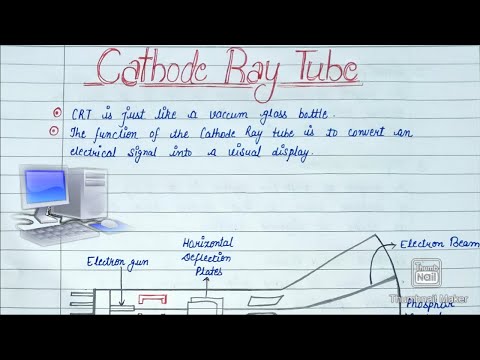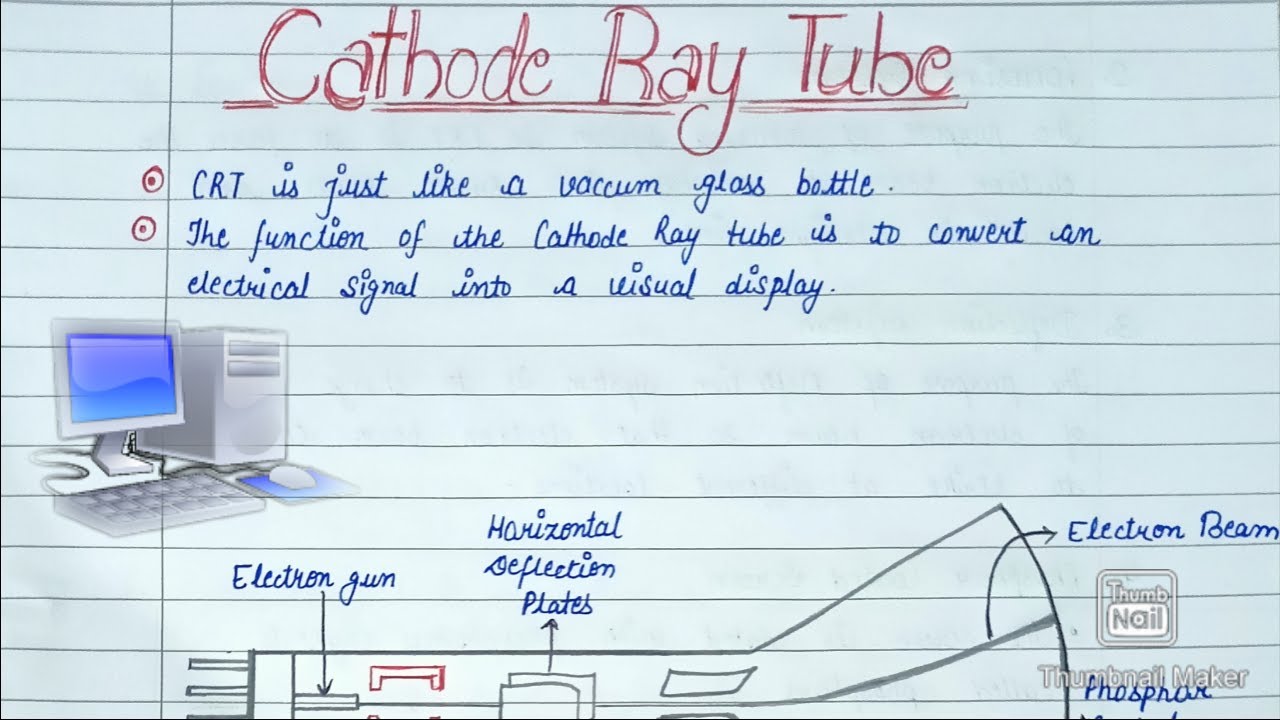A cathode ray tube (CRT) is a fascinating piece of technology that revolutionized the world of visual display. With its unique design and functionality, a CRT captures the imagination of anyone interested in the evolution of television and computer monitors. This ingenious device employs a cathode ray to emit a focused beam of electrons onto a phosphorescent screen, resulting in the creation of vibrant and detailed images. The concept behind a CRT involves the precise manipulation of these electron beams through the use of electromagnetic fields, allowing for the production of sharp and colorful visuals. One of the most intriguing aspects of a CRT is its cathode ray tube itself. This vacuum-sealed glass tube houses the entire display mechanism, which includes a cathode, electron guns, and a phosphor-coated screen. The tube’s ability to control and direct the electron beams with remarkable precision is what sets it apart from later display technologies. This historical significance, combined with the aesthetic charm of a CRT, makes it a captivating subject for enthusiasts and collectors alike. From vintage television sets to classic arcade cabinets, CRTs hold a nostalgic appeal for many. The warm glow and distinctive scan lines of these displays evoke memories of a bygone era, transporting us back to a time when technology was simpler yet no less impactful. Exploring the inner workings and historical context of a CRT can provide a deeper appreciation for the strides made in display technology over the years. In conclusion, a cathode ray tube (CRT) stands as a testament to human ingenuity and the relentless pursuit of visual excellence. Its unique design and historical significance make it a captivating subject for those interested in the evolution of display technology. Whether you’re a technology enthusiast, a history buff, or simply intrigued by the charm of vintage electronics, delving into the world of CRTs is sure to ignite your curiosity.

What is a CRT?
| Term | Description |
|---|---|
| CRT | Cathode Ray Tube |
| Definition | A CRT is a vacuum tube containing an electron gun and a phosphorescent screen, used to display images in older television sets and computer monitors. |
| Technology | Based on the principle of cathode rays, CRTs utilize a high-voltage electron beam that scans across the screen line by line, illuminating phosphor dots and creating the desired image. |
| Advantages | CRTs were the dominant display technology for several decades due to their superior color reproduction, high contrast ratios, and fast response times, making them ideal for graphic-intensive applications. |
| Disadvantages | Despite their advantages, CRTs are bulky and heavy, requiring a significant amount of desk space. They also consume more power compared to modern display technologies and are prone to screen flickering. |
| Obsolete | With the advent of LCD, LED, and OLED displays, CRTs have become largely obsolete in consumer electronics. However, they are still used in certain niche applications such as specialized monitors, oscilloscopes, and vintage gaming enthusiasts. |
“The Magic Behind the Screen: Unveiling the Wonders of the Cathode Ray Tube”
What is a CRT?
A Cathode Ray Tube (CRT) is a type of display technology that was widely used in television sets and computer monitors before the advent of flat-panel displays. It was invented by German engineer Karl Ferdinand Braun in 1897 and remained the dominant technology for more than a century.
The Working Principle of a CRT
The basic working principle of a CRT involves the use of an electron gun that emits a beam of electrons. This electron beam is accelerated and focused onto a phosphor-coated screen, which emits light when struck by the electrons. The image on the screen is created by controlling the intensity and position of the electron beam using magnetic fields.
Components of a CRT
A CRT consists of several key components:
The Electron Gun
The electron gun is responsible for emitting and controlling the electron beam. It consists of a cathode, which emits the electrons, and focusing and deflecting electrodes that shape and direct the beam.
The Deflection System
The deflection system consists of magnetic coils that generate magnetic fields, which deflect the electron beam horizontally and vertically across the screen. By controlling the strength and direction of these magnetic fields, the position of the electron beam can be accurately controlled to create the desired image.
The Phosphor-Coated Screen
The phosphor-coated screen is the part of the CRT where the electron beam strikes and produces light. The phosphors are materials that emit visible light when excited by the electrons. Different phosphors can produce different colors, allowing for full-color displays.
The Shadow Mask or Aperture Grill
The shadow mask or aperture grill is a perforated metal sheet located just behind the phosphor-coated screen. Its purpose is to ensure that the electron beam only strikes the intended phosphors, preventing color bleeding and distortion.
The Vacuum Tube
The entire CRT is housed within a vacuum tube, which helps preserve the integrity of the electron beam by preventing it from interacting with air molecules. The vacuum also eliminates the need for a protective cover, allowing for direct contact with the screen.
Advantages and Disadvantages of CRTs
Advantages:
– Superior color reproduction and image quality
– Wide viewing angles
– Ability to display high refresh rates
Disadvantages:
– Bulky and heavy
– High power consumption
– Limited screen resolutions
The Decline of CRTs
Despite their numerous advantages in image quality, CRTs started to lose their popularity in the late 1990s with the introduction of LCD (Liquid Crystal Display) technology. LCDs offered significant advantages over CRTs, including thinner profiles, lighter weight, lower power consumption, and higher screen resolutions.
The transition from CRTs to flat-panel displays was further accelerated by the introduction of plasma displays and eventually LED (Light-Emitting Diode) technology, which offered even better image quality and energy efficiency.
The Legacy of CRTs
Although CRTs are now considered outdated technology, they still hold a special place in the history of displays. They revolutionized how we consume media and paved the way for the development of modern display technologies. Today, CRTs are mainly found in older televisions and computer monitors, but their impact on the industry cannot be overlooked.
In conclusion, the Cathode Ray Tube (CRT) was a groundbreaking display technology that dominated the market for over a century. Its working principle, components, advantages, and disadvantages, as well as its decline and legacy, all contribute to its significance in the history of displays.

